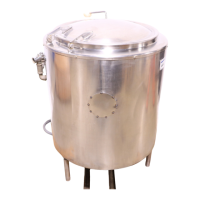OM-AH-30 13
Sequence of Operation
The following “action-reaction” outline is provided to help understand how the kettle
works.
1. When the power switch is turned on, it starts the spark igniter and opens the
automatic valve for the pilot burner. The spark ignites a pilot flame, which heats
the sensor. The sensor then sends a signal to turn off the spark. The flame
thereafter acts as a standing pilot until the power is turned off.
2. If the pilot flame is not sensed within 90 seconds after spark begins, a timer
shuts down the entire operation. To attempt a second trial for ignition, turn off
the power switch. Check the gas supply valves and wait five minutes before
trying again by switching power on. If you cannot establish a pilot flame in
four tries, close all valves, turn off the power, and contact an authorized Service
Agency.
3. When the operator sets a temperature on the thermostat, it causes the automatic
valve to admit gas to the main burner, where it is ignited by the pilot flame.
When the kettle reaches the set temperature, the thermostat switch opens. This
stops the signal to the gas control valve and shuts off gas to the main burner.
The pilot flame stays lit.
4. When the kettle cools below the set temperature, the thermostat switch closes
and start another cycle. On and off cycling continues and maintains the kettle at
the desired temperature. This action is indicated by the Heat Indicator light.
The kettle has the following safety features in addition to the 90-second ignition timer:
1. Low water cutoff relay that will shut off gas supplies to all burners until the
jacket water level is corrected.
2. High limit pressure switch, set to open at about 26 PSI and to shut down the
burners until jacket pressure is decreased.
3. Pressure relief safety valve, which will release steam if jacket pressure exceeds
30 PSI.
4. Gas pressure regulator built into the gas control valve.

